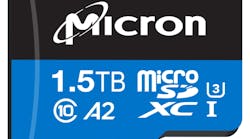Technology innovations — such as 5G, artificial intelligence (AI) and the Internet of Things (IoT) — are driving the growth of AI-enabled camera use cases in video security applications. Selecting storage specifically designed to concurrently handle high-quality video recordings requires application-optimized microSD cards that capture multiple AI workloads.
David Henderson, the Director of Industrial Segment for Micron Technology’s Embedded Business Unit discusses the evolution and application of edge storage for AI-enhanced video applications with Security Technology Executive.
STE: Technology innovations such as Artificial intelligence (AI) and the Internet of Things (IoT) are converging at the edge and enabling a wide range of new products, services, and applications for the video security industry. Could you please share more insights into the implications for the storage industry?
Henderson: The growing market of cloud-based video security solutions is accelerating the adoption of in-camera edge storage which brings the benefits of bandwidth reduction and better scalability since no physical recording systems are required. In addition, with the adoption of AI functionality in camera devices, a richer database will be created and stored at the edge. Thus, edge storage is becoming a key element of cloud-based, AI-enabled video security applications.
STE: Can you give us some examples of the use cases?
- Video Security as a Service (VSaaS)
- Smart home
- Mobile security
- Video telematics
Video Security as a Service (VSaaS)
VSaaS, a cloud-based video security solution, has become increasingly popular in recent years, mainly because of its ease of deployment. With no need for Network Video Recorders ( NVRs), servers, or complicated wiring, data is stored on the edge and transferred to the cloud as needed. This combination of edge and cloud means that collected data can be stored on the camera itself—on a microSD card—and then transferred to the cloud for easy access, saving precious bandwidth. A wide variety of AI analytics can also be applied to VSaaS solutions to provide users with smart data to proactively keep their premises safe and secure.
Smart home
The smart home market has witnessed significant growth over the past few years, greatly enabled by IoT.
Video security cameras and video doorbells have become key components of today’s smart home. Easy to install and easy to monitor, modern home security cameras and video doorbells provide homeowners with an affordable way to secure their homes, all while providing access to video from the palm of their hand. Edge storage on smart home devices makes DIY installation of cameras much easier, doing away with unnecessary, complicated wiring to a physical storage system. In addition, applying AI to smart home devices can reduce false alarms caused by user error or non-threatening triggers.
Mobile security
Body-worn cameras for mobile security applications have become increasingly popular in law enforcement and enterprise wearable camera sectors such as security agencies, retailers, warehousing, and logistics. Video and audio recordings are stored directly on an onboard microSD card and then streamed or managed centrally through integration with a video or evidence management system for immediate response, incident management, or training purposes. AI-enabled body cameras can automatically capture vital events and effectively help my data.
Video telematics
Video telematics combines video with vehicle data to improve fleet management. Built-in AI provides real-time analysis and alerts to drivers, increasing vehicle safety and collision avoidance. At the same time, data can be transferred via the cloud so that fleet managers can get a great degree of oversight over employees and assets. Edge storage in video telematics is a critical part of incident management for fleet managers.
STE: As you described earlier, there is increasing demand for edge storage in AI-enhanced video applications, could you share with us what are the challenges for edge storage while it moves into AI-enabled applications?
Henderson: The challenge is, storage workloads can significantly impact a memory card’s performance. With AI adoption in camera devices, the data storage workload will migrate from video data to a combination of video and AI metadata. The AI metadata storage will generate more random write operations. Because the storage workload of an AI-enabled camera device is different than a standard camera device (many more random write operations are seen in AI-enabled camera storage workloads), a memory card must contain a workload-optimized solution while it’s used in an AI-enabled camera device.
STE: What are the key differentiations of Micron’s edge storage solution?Henderson: Unlike most memory cards on the market that are consumer-grade and have limited write capability, Micron’s i400 microSD cards are designed for AI-enhanced video applications with features such as:
High endurance (64GB to 1.5TB)
- Supports up to 5 years of high-quality, continuous, 24/7 video recording and up to 4 months of storage.
Outstanding recording performance
- Optimized design delivers sustained performance for concurrent 4K video recording and up to 8 AI capture events every second.
Industrial quality
- Reliable high quality provides a 2 million hour mean time to failure (MTTF) rating, plus 5-proof protection encompassing water, shock, x-ray, magnet and impact.
Smart management
- Health monitoring tracks usage and card health, and the field firmware update provides a secure way for the card to be updated remotely when needed.








